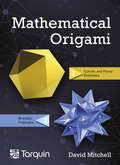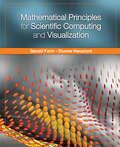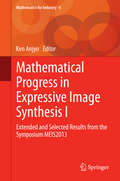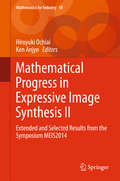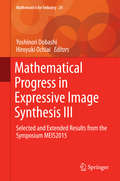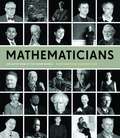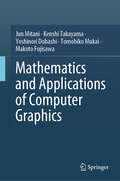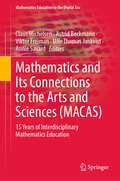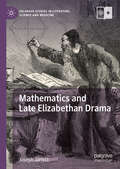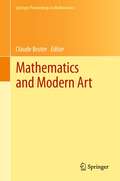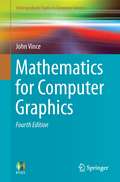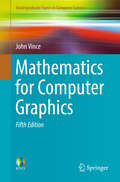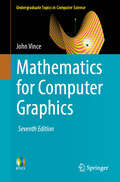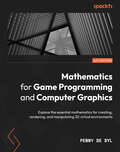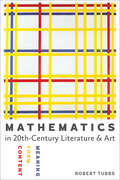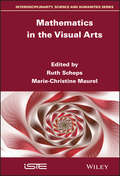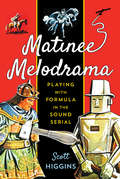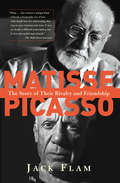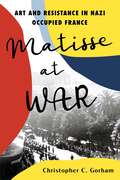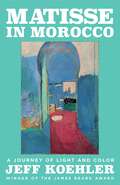- Table View
- List View
Mathematical Origami: Geometrical shapes by paper folding
by David MitchellThis book shows the reader how to make a range of robust polyhedra from ordinary printer paper using a technique known as modular origami. Modular origami designs are made by first folding several, or sometimes many, sheets of paper into simple individual modules and then by putting these modules together, normally without the help of any kind of adhesive, to create a finished polyhedral form. Modular origami design has moved on since the hugely popular first edition which has been expanded and revised to present both a wider range of designs, and to introduce new designs which are more robust and offer more potential for mathematical adventures. Ideal for the classroom and fun for any enthusiast of either origami, or mathematics. David Mitchell gives clear step-by-step instructions.
Mathematical Principles for Scientific Computing and Visualization
by Gerald Farin Dianne HansfordThis non-traditional introduction to the mathematics of scientific computation describes the principles behind the major methods, from statistics, applied mathematics, scientific visualization, and elsewhere, in a way that is accessible to a large part of the scientific community. Introductory material includes computational basics, a review of coo
Mathematical Progress in Expressive Image Synthesis I
by Ken AnjyoThis book presents revised versions of the best papers selected from the symposium "Mathematical Progress in Expressive Image Synthesis" (MEIS2013) held in Fukuoka, Japan, in 2013. The topics cover various areas of computer graphics (CG), such as surface deformation/editing, character animation, visual simulation of fluids, texture and sound synthesis and photorealistic rendering. From a mathematical point of view, the book also presents papers addressing discrete differential geometry, Lie theory, computational fluid dynamics, function interpolation and learning theory. This book showcases the latest joint efforts between mathematicians, CG researchers and practitioners exploring important issues in graphics and visual perception. The book provides a valuable resource for all computer graphics researchers seeking open problem areas, especially those now entering the field who have not yet selected a research direction.
Mathematical Progress in Expressive Image Synthesis II
by Hiroyuki Ochiai Ken AnjyoThe material included in this book provides selected presentations given at the international symposium MEIS2014. The book aims to provide a unique venue where various issues in computer graphics (CG) application fields are discussed by mathematicians as well as CG researchers and practitioners. The target audience is not limited to researchers in academia but also those in industries with a strong interest in digital media creation, scientific visualization and visual engineering.
Mathematical Progress in Expressive Image Synthesis III
by Yoshinori Dobashi Hiroyuki Ochiai"Progress in Expressive Image Synthesis"(MEIS2015), was held in Fukuoka, Japan, September 25-27, 2015. The aim of thesymposium was to provide a unique venue where various issues in computergraphics (CG) application fields could be discussed by mathematicians, CGresearchers, and practitioners. Through the previous symposiums MEIS2013 andMEIS2014, mathematicians as well as CG researchers have recognized that CG is aspecific and practical activity derived from mathematical theories. Issuesfound in CG broaden the field of mathematics and vice versa, and CG visualizesmathematical theories in an aesthetic manner. In this volume, the editors aim toprovoke interdisciplinary research projects through the peer-reviewed papersand poster presentations at the this year's symposium. This book capturesinteractions among mathematicians, CG researchers, and practitioners sharingimportant, state-of-the-art issues in graphics and visual perception. The bookis suitable for all CG researchers seeking open problem areas and especiallyfor those entering the field who have not yet selected a research direction.
Mathematical and Computational Oncology: First International Symposium, ISMCO 2019, Lake Tahoe, NV, USA, October 14–16, 2019, Proceedings (Lecture Notes in Computer Science #11826)
by Ken Chen George Bebis Takis Benos Katharina Jahn Ernesto LimaThis book constitutes the refereed proceedings of the First International Symposium on Mathematical and Computational Oncology, ISMCO'2019, held in Lake Tahoe, NV, USA, in October 2019. The 7 full papers presented were carefully reviewed and selected from 30 submissions. The papers are organized in topical sections named: Tumor evolvability and intra-tumor heterogeneity; Imaging and scientific visualization for cancer research; Statistical methods and data mining for cancer research (SMDM); Spatio-temporal tumor modeling and simulation (STTMS).
Mathematical and Computational Oncology: Second International Symposium, ISMCO 2020, San Diego, CA, USA, October 8–10, 2020, Proceedings (Lecture Notes in Computer Science #12508)
by George Bebis Max Alekseyev Heyrim Cho Jana Gevertz Maria Rodriguez MartinezThis book constitutes the refereed proceedings of the Second International Symposium on Mathematical and Computational Oncology, ISMCO 2020, which was supposed to be held in San Diego, CA, USA, in October 2020, but was instead held virtually due to the COVID-19 pandemic.The 6 full papers and 4 short papers presented together with 1 invited talk were carefully reviewed and selected from 28 submissions. The papers are organized in topical sections named: statistical and machine learning methods for cancer research; mathematical modeling for cancer research; general cancer computational biology; and posters.
Mathematical and Computational Oncology: Third International Symposium, ISMCO 2021, Virtual Event, October 11–13, 2021, Proceedings (Lecture Notes in Computer Science #13060)
by George Bebis Terry Gaasterland Mamoru Kato Mohammad Kohandel Kathleen WilkieThis book constitutes the refereed proceedings of the Third International Symposium on Mathematical and Computational Oncology, ISMCO 2021, held in October 2021. Due to COVID-19 pandemic the conference was held virtually.The 3 full papers and 4 short papers presented were carefully reviewed and selected from 20 submissions. The papers are organized in topical sections named: statistical and machine learning methods for cancer research; mathematical modeling for cancer research; spatio-temporal tumor modeling and simulation; general cancer computational biology; mathematical modeling for cancer research; computational methods for anticancer drug development.
Mathematicians
by Robert C. Gunning Mariana CookMathematicians is a remarkable collection of ninety-two photographic portraits, featuring some of the most amazing mathematicians of our time. Acclaimed photographer Mariana Cook captures the exuberant and colorful personalities of these brilliant thinkers and the superb images are accompanied by brief autobiographical texts written by each mathematician. Together, the photographs and words illuminate a diverse group of men and women dedicated to the absorbing pursuit of mathematics. The compelling black-and-white portraits introduce readers to mathematicians who are young and old, fathers and daughters, and husbands and wives. They include Fields Medal winners, those at the beginning of major careers, and those who are long-established celebrities in the discipline. Their candid personal essays reveal unique and wide-ranging thoughts, opinions, and humor, as the mathematicians discuss how they became interested in mathematics, why they love the subject, how they remain motivated in the face of mathematical challenges, and how their greatest contributions have paved new directions for future generations. Mathematicians in the book include David Blackwell, Henri Cartan, John Conway, Pierre Deligne, Timothy Gowers, Frances Kirwan, Peter Lax, William Massey, John Milnor, Cathleen Morawetz, John Nash, Karen Uhlenbeck, and many others. Conveying the beauty and joy of mathematics to those both within and outside the field, this photographic collection is an inspirational tribute to mathematicians everywhere.
Mathematics and Applications of Computer Graphics
by Yoshinori Dobashi Jun Mitani Kenshi Takayama Tomohiko Mukai Makoto FujisawaThis book equips readers with the fundamentals of 3DCG that support the advanced technologies. The content of this book is divided into four categories: modeling, rendering, character animation, and physical simulation, and each is explained in a separate chapter. In simpler terms, these four technologies can be described as creating shapes, creating images, creating motion, and reproducing the behavior of the natural world. The "Modeling" chapter describes the theory behind describing the shape of an object using surface meshes and then editing and manipulating them. The chapter "Rendering" focuses on the calculation of the luminance of an object's surface, and describes methods for calculating global illumination and generating fast images using precomputation to produce realistic images. Physical phenomena such as light scattering, which is necessary to improve realism, are also explained. The "Character Animation" chapter introduces the skeleton method, a standard technique in animation production, and describes various animation editing techniques for humanoid character models. Finally, the chapter on "Physical Simulation" describes methods to compute the behavior of complex natural phenomena, including not only hard objects but also flowing objects such as water and air. The four topics listed here are the fundamental elements that support 3DCG. The chapters were written by researchers who are active at the forefront of their respective fields. Each of the authors has a remarkable track record and can be said to have led the development of 3DCG technology in Japan with their wealth of experience and knowledge. To understand the mathematical content of this book, basic knowledge of analysis and linear algebra is required. This book is suitable for upper undergraduate and graduate students in computer science, engineering, and other fields in science, and is also useful for practitioners in game production and those who are interested in 3DCG.
Mathematics and Its Connections to the Arts and Sciences: 15 Years of Interdisciplinary Mathematics Education (Mathematics Education in the Digital Era #19)
by Viktor Freiman Annie Savard Claus Michelsen Astrid Beckmann Uffe Thomas JankvistThis book celebrates the 15th anniversary of the bi-annual symposium series Mathematics and its Connections to the Arts and Sciences (MACAS), which was first held in 2005 following the continued collaboration of an international group of researchers from ICME Topic Study Group 21. The MACAS-conferences bring together scientists and educators who are interested in the connection between mathematics, arts and science in educational curriculum, while emphasizing on, as well as researching about, the role of mathematics. By pooling together these different approaches and viewpoints between mathematics, arts and sciences, this book reveals possible synergies and paths for collaborations. In view of the challenges of the 21st century, a modern approach to education with a focus on multi- and interdisciplinarity is more important than ever. The role of mathematics assumes a key role in this approach as it is connected to all other disciplines, such as STEM education, physics, chemistry, biology, aesthetics and language, and can serve as a bridge between them. This book discusses, amongst others, the curricular approaches to integrate mathematics and other disciplines, the importance of mathematical modelling and the interdisciplinarity ways for learning and studying of mathematics, as well as the intercultural dimensions of mathematics and mathematics in the digital era. All topics will be presented from very different perspectives and regarding very different contexts, including digitization, culture and sustainability. This unique collection will serve as a very valuable and compact source for all above mentioned scientists and educators, as well as for use in advanced teacher education courses.
Mathematics and Late Elizabethan Drama (Palgrave Studies in Literature, Science and Medicine)
by Joseph JarrettThis book considers the influence that sixteenth-century and early seventeenth-century mathematical thinking exerted on the writing and production of popular drama between about 1587 and 1603. It concentrates upon six plays by five early modern dramatists: Tamburlaine, Part 1 (1587) and Tamburlaine, Part 2 (1587) by Christopher Marlowe; Friar Bacon and Friar Bungay (1589) by Robert Greene; Old Fortunatus (1599) by Thomas Dekker; Hamlet (1600) by William Shakespeare; and The Tragedy of Hoffman (1603) by Henry Chettle. Each chapter analyses how the terms, concepts, and implications of contemporary mathematics impacted upon these plays’ vocabularies, forms, and aesthetic and dramaturgical effects and affects.
Mathematics and Modern Art
by Claude BruterThe link between mathematics and art remains as strong today as it was in the earliest instances of decorative and ritual art. Arts, architecture, music and painting have for a long time been sources of new developments in mathematics, and vice versa. Many great painters have seen no contradiction between artistic and mathematical endeavors, contributing to the progress of both, using mathematical principles to guide their visual creativity, enriching their visual environment with the new objects created by the mathematical science. Owing to the recent development of the so nice techniques for visualization, while mathematicians can better explore these new mathematical objects, artists can use them to emphasize their intrinsic beauty, and create quite new sceneries. This volume, the content of the first conference of the European Society for Mathematics and the Arts (ESMA), held in Paris in 2010, gives an overview on some significant and beautiful recent works where maths and art, including architecture and music, are interwoven. The book includes a wealth of mathematical illustrations from several basic mathematical fields including classical geometry, topology, differential geometry, dynamical systems. Here, artists and mathematicians alike elucidate the thought processes and the tools used to create their work
Mathematics for Computer Graphics
by John A. VinceJohn Vince explains a wide range of mathematical techniques and problem-solving strategies associated with computer games, computer animation, virtual reality, CAD, and other areas of computer graphics. Covering all the mathematical techniques required to resolve geometric problems and design computer programs for computer graphic applications, each chapter explores a specific mathematical topic prior to moving forward into the more advanced areas of matrix transforms, 3D curves and surface patches. Problem-solving techniques using vector analysis and geometric algebra are also discussed. All the key areas are covered including: Numbers, Algebra, Trigonometry, Coordinate geometry, Transforms, Vectors, Curves and surfaces, Barycentric coordinates, Analytic geometry. Plus - and unusually in a student textbook - a chapter on geometric algebra is included.
Mathematics for Computer Graphics
by John VinceJohn Vince explains a wide range of mathematical techniques and problem-solving strategies associated with computer games, computer animation, virtual reality, CAD and other areas of computer graphics in this updated and expanded fourth edition. The first four chapters revise number sets, algebra, trigonometry and coordinate systems, which are employed in the following chapters on vectors, transforms, interpolation, 3D curves and patches, analytic geometry and barycentric coordinates. Following this, the reader is introduced to the relatively new topic of geometric algebra, and the last two chapters provide an introduction to differential and integral calculus, with an emphasis on geometry. Mathematics for Computer Graphics covers all of the key areas of the subject, including: Number sets Algebra Trigonometry Coordinate systems Transforms Quaternions Interpolation Curves and surfaces Analytic geometry Barycentric coordinates Geometric algebra Differential calculus Integral calculus This fourth edition contains over 120 worked examples and over 270 illustrations, which are central to the author's descriptive writing style. Mathematics for Computer Graphics provides a sound understanding of the mathematics required for computer graphics, giving a fascinating insight into the design of computer graphics software and setting the scene for further reading of more advanced books and technical research papers.
Mathematics for Computer Graphics
by John VinceJohn Vince explains a wide range of mathematical techniques and problem-solving strategies associated with computer games, computer animation, virtual reality, CAD and other areas of computer graphics in this completely revised and expanded fifth edition. The first five chapters cover a general introduction, number sets, algebra, trigonometry and coordinate systems, which are employed in the following chapters on vectors, matrix algebra, transforms, interpolation, curves and patches, analytic geometry and barycentric coordinates. Following this, the reader is introduced to the relatively new topic of geometric algebra, followed by two chapters that introduce differential and integral calculus. Finally, there is a chapter on worked examples. Mathematics for Computer Graphics covers all of the key areas of the subject, including: #65533; Number sets #65533; Algebra #65533; Trigonometry #65533; Coordinate systems #65533; Determinants#65533; Vectors #65533; Quaternions #65533; Matrix algebra #65533; Geometric transforms #65533; Interpolation #65533; Curves and surfaces #65533; Analytic geometry #65533; Barycentric coordinates #65533; Geometric algebra #65533; Differential calculus #65533; Integral calculus This fifth edition contains over 120 worked examples and over 320 colour illustrations, which are central to the author's descriptive writing style. Mathematics for Computer Graphics provides a sound understanding of the mathematics required for computer graphics, giving a fascinating insight into the design of computer graphics software and setting the scene for further reading of more advanced books and technical research papers.
Mathematics for Computer Graphics (Undergraduate Topics in Computer Science)
by John VinceJohn Vince explains a comprehensive range of mathematical techniques and problem-solving strategies associated with computer games, computer animation, special effects, virtual reality, CAD and other areas of computer graphics in this completely revised and expanded seventh edition. The first five chapters cover a general introduction, number sets, algebra, trigonometry and coordinate systems, which are employed in the following chapters on determinants, vectors, matrix algebra, complex numbers, geometric transforms, quaternion algebra, quaternions in space, interpolation, statistics, curves and patches, analytical geometry and barycentric coordinates. Following this, the reader is introduced to the relatively new subject of geometric algebra, followed by two chapters that introduce differential and integral calculus. Finally, there are chapters on Fourier analysis and Worked examples. Mathematics for Computer Graphics covers all of the key areas of the subject, including: • Number sets • Algebra • Trigonometry • Complex numbers • Coordinate systems • Determinants • Vectors • Quaternions • Matrix algebra • Geometric transforms • Interpolation • Curves and surfaces • Analytic geometry • Statistics • Barycentric coordinates • Geometric algebra • Differential calculus • Integral calculus • Fourier analysis This seventh edition contains approximately 200 worked examples and over 350 colour illustrations, which are central to the author’s descriptive writing style. Mathematics for Computer Graphics provides a sound understanding of the mathematics required for computer graphics software and setting the scene for further reading of more advanced books and technical research papers.
Mathematics for Game Programming and Computer Graphics: Explore the essential mathematics for creating, rendering, and manipulating 3D virtual environments
by Penny de BylA comprehensive guide to learning fundamental 3D mathematical principles used in games and computer graphics by exampleKey FeaturesGet acquainted with the essential mathematics needed to describe, simulate, and render 3D creationsConstruct and manipulate 3D animated environments using Python, Pygame, and PyOpenGLDevelop vertex and fragment shaders in OpenGL shader language to speed up renderingBook DescriptionMathematics is an essential skill when it comes to graphics and game development, particularly if you want to understand the generation of real-time computer graphics and the manipulation of objects and environments in a detailed way. Python, together with Pygame and PyOpenGL, provides you with the opportunity to explore these features under the hood, revealing how computers generate and manipulate 3D environments.Mathematics for Game Programming and Computer Graphics is an exhaustive guide to getting “back to the basics” of mathematics, using a series of problem-based, practical exercises to explore ideas around drawing graphic lines and shapes, applying vectors and vertices, constructing and rendering meshes, and working with vertex shaders. By leveraging Python, Pygame, and PyOpenGL, you'll be able to create your own mathematics-based engine and API that will be used throughout to build applications.By the end of this graphics focussed book, you'll have gained a thorough understanding of how essential mathematics is for creating, rendering, and manipulating 3D virtual environments and know the secrets behind today's top graphics and game engines.What you will learnGet up and running with Python, Pycharm, Pygame, and PyOpenGLExperiment with different graphics API drawing commandsReview basic trigonometry and how it's important in 3D environmentsApply vectors and matrices to move, orient, and scale 3D objectsRender 3D objects with textures, colors, shading, and lightingWork with vertex shaders for faster GPU-based renderingWho this book is forThis book is for programmers who want to enhance their 3D mathematics skills relating to computer graphics and computer games. Knowledge of high school–level mathematics and a working understanding in an object-orientated language is needed to grasp the contents present in this book.
Mathematics in Twentieth-Century Literature & Art: Content, Form, Meaning
by Robert TubbsThe author of What Is a Number? examines the relationship between mathematics and art and literature of the 20th century.During the twentieth century, many artists and writers turned to abstract mathematical ideas to help them realize their aesthetic ambitions. Man Ray, Marcel Duchamp, and, perhaps most famously, Piet Mondrian used principles of mathematics in their work. Was it coincidence, or were these artists following their instincts, which were ruled by mathematical underpinnings, such as optimal solutions for filling a space? If math exists within visual art, can it be found within literary pursuits? In short, just what is the relationship between mathematics and the creative arts?In this exploration of mathematical ideas in art and literature, Robert Tubbs argues that the links are much stronger than previously imagined and exceed both coincidence and commonality of purpose. Not only does he argue that mathematical ideas guided the aesthetic visions of many twentieth-century artists and writers, Tubbs further asserts that artists and writers used math in their creative processes even though they seemed to have no affinity for mathematical thinking.In the end, Tubbs makes the case that art can be better appreciated when the math that inspired it is better understood. An insightful tour of the great masters of the last century and an argument that challenges long-held paradigms, this book will appeal to mathematicians, humanists, and artists, as well as instructors teaching the connections among math, literature, and art.“Though the content of Tubbs’s book is challenging, it is also accessible and should interest many on both sides of the perceived divide between mathematics and the arts.” —Choice
Mathematics in Twentieth-Century Literature and Art: Content, Form, Meaning
by Robert TubbsChips away at the notion of an accidental relationship between math and art and literature.During the twentieth century, many artists and writers turned to abstract mathematical ideas to help them realize their aesthetic ambitions. Man Ray, Marcel Duchamp, and, perhaps most famously, Piet Mondrian used principles of mathematics in their work. Was it mere coincidence, or were these artists simply following their instincts, which in turn were ruled by mathematical underpinnings, such as optimal solutions for filling a space? If math exists within visual art, can it be found within literary pursuits? In short, just what is the relationship between mathematics and the creative arts?In this provocative, original exploration of mathematical ideas in art and literature, Robert Tubbs argues that the links are much stronger than previously imagined and exceed both coincidence and commonality of purpose. Not only does he argue that mathematical ideas guided the aesthetic visions of many twentieth-century artists and writers, Tubbs further asserts that artists and writers used math in their creative processes even though they seemed to have no affinity for mathematical thinking. In the end, Tubbs makes the case that art can be better appreciated when the math that inspired it is better understood. An insightful tour of the great masters of the last century and an argument that challenges long-held paradigms, Mathematics in Twentieth-Century Literature and Art will appeal to mathematicians, humanists, and artists, as well as instructors teaching the connections among math, literature, and art.
Mathematics in the Visual Arts
by Marie-Christine Maurel Ruth SchepsArt and science are not separate universes. This book explores this claim by showing how mathematics, geometry and numerical approaches contribute to the construction of works of art. This applies not only to modern visual artists but also to important artists of the past. To illustrate this, this book studies Leonardo da Vinci, who was both an engineer and a painter, and whose paintings can be perfectly modeled using simple geometric curves. The world gains intelligibility through elegant mathematical frameworks – from the projective spaces of painting to the most complex phase spaces of theoretical physics. A living example of this interdisciplinarity would be the sculptures of Jean Letourner, a specialist in both chaos sciences and carving, as evidenced in his stonework. This book also exemplifies the geometry and life of forms through contemporary works of art – including fractal art – which have never before been represented in this type of work.
Matinee Melodrama
by Scott HigginsLong before Batman, Flash Gordon, or the Lone Ranger were the stars of their own TV shows, they had dedicated audiences watching their adventures each week. The difference was that this action took place on the big screen, in short adventure serials whose exciting cliffhangers compelled the young audience to return to the theater every seven days. Matinee Melodrama is the first book about the adventure serial as a distinct artform, one that uniquely encouraged audience participation and imaginative play. Media scholar Scott Higgins proposes that the serial's incoherent plotting and reliance on formula, far from being faults, should be understood as some of its most appealing attributes, helping to spawn an active fan culture. Further, he suggests these serials laid the groundwork not only for modern-day cinematic blockbusters like Star Wars and Raiders of the Lost Ark, but also for all kinds of interactive media that combine spectacle, storytelling, and play. As it identifies key elements of the serial form--from stock characters to cliffhangers--Matinee Melodrama delves deeply into questions about the nature of suspense, the aesthetics of action, and the potentials of formulaic narrative. Yet it also provides readers with a loving look at everything from Zorro's Fighting Legion to Daredevils of the Red Circle, conveying exactly why these films continue to thrill and enthrall their fans.
Matisse and Picasso: The Story of Their Rivalry and Friendship
by Jack FlamMatisse and Picasso achieved extraordinary prominence during their lifetimes. They have become cultural icons, standing not only for different kinds of art but also for different ways of living. Matisse, known for his restraint and intense sense of privacy, for his decorum and discretion, created an art that transcended daily life and conveyed a sensuality that inhabited an abstract and ethereal realm of being. In contrast, Picasso became the exemplar of intense emotionality, of theatricality, of art as a kind of autobiographical confession that was often charged with violence and explosive eroticism. In Matisse and Picasso, Jack Flam explores the compelling, competitive, parallel lives of these two artists and their very different attitudes toward the idea of artistic greatness, toward the women they loved, and ultimately toward their confrontations with death.
Matisse at War: Art and Resistance in Nazi Occupied France
by Christopher C. GorhamSpotlighting the years during WWII when Henri Matisse and his family defiantly refused to evacuate Nazi-occupied France, this groundbreaking book illuminates the previously untold history of their passionate roles in the Resistance and the prodigious, revolutionary work the artist produced in the face of fascism, violence, and hate. For readers of Jeffrey H. Jackson&’s Paper Bullets, Martin Dugard&’s Taking Paris, Julie Orringer&’s The Flight Portfolio, and Picasso&’s War by Hugh Eakin – from the acclaimed author of The Confidante. In 1940, with the Nazis sweeping through France, Henri Matisse found himself at a personal and artistic crossroads. His 42-year marriage had ended, he was gravely ill, and after decades at the forefront of modern art, he was beset by doubt. As scores of famous figures escaped the country, Matisse took refuge in Nice, with his companion, Lydia Delectorskaya. By defiantly remaining, Matisse was a source of inspiration for his nation. While enemy agents and Resistance fighters played cat-and-mouse in the alleyways of Nice, Matisse&’s son, Jean, engaged in sabotage efforts with the Allies. In Paris, under the swastika, Matisse&’s estranged wife, Amélie, worked for the Communist underground. His beloved daughter, Marguerite, active in the French Resistance, was arrested and tortured by the Gestapo, sentenced to Ravensbruck concentration camp—and miraculously escaped when her train was halted by Allied bombs. His younger, son, Pierre helped Jewish artists escape to New York; even his teenaged grandson risked his life by defying the Germans and their Vichy collaborators. Amidst this chaos, Matisse responded to the dark days of war by inventing a dazzling new paper technique that led to some of his most iconic pieces, including The Fall of Icarus, his profile of Charles De Gaulle, Monsieur Loyal, and his groundbreaking cut-out book, Jazz. His wartime works were acts of resistance, subtly patriotic and daringly new. Drawing on intimate letters and a multitude of other sources, Christopher C. Gorham illuminates this momentous stage of Matisse&’s life as never before, revealing an artist on a journey of reinvention, wrenching meaning from the suffering of war, and holding up the light of human imagination against the torch of fascism to create some of the most exciting work of his career, of the 20th century, and in the history of art.
Matisse in Morocco: A Journey of Light and Color
by Jeff KoehlerThe remarkable and little-known story of the two groundbreaking winters that Henri Matisse spent painting in Morocco, a fertile period that transformed his art and marked his work until the very end.In winter of 1912, Henri Matisse—forty-two, nearing mid-career, and yet to find lasting critical acceptance, public admiration, or financial security since exploding to the forefront of the avant-garde in 1905 with his iconoclastic Fauve paintings—was struggling. Once the vanguard leader, the Parisian avant-garde now considered him passé. His important early collectors, including Gertrude and Leo Stein, had stopped buying his work and were fully championing Picasso, and he had exhibited little in the last few years. In the face of Cubism that was now dominating the art scene, Matisse needed to get away from Paris in order to advance his distinctive artistic vision. Almost on a whim, he went to Tangier. Matisse had already been profoundly inspired by Islamic art, and was primed for his arrival in the Moroccan city where such art was integrated into everyday life. Despite the challenges of rain, insomnia, depression, and finding models, the sojourn was such a success he returned the following winter, which would lead to even greater artistic triumph. Matisse in Morocco tells the story of the artist's groundbreaking time in Tangier and how it altered Matisse&’s development as a painter and indelibly marked his work for the next four decades. Through Koehler's research and travel, we experience Matisse's time in Tangier, the paintings and their subjects, his relationships with his wife Amélie and his two important collectiors, and then come to understand the impact Morocco—its light, colors, culture, and artistic traditions—had on his art. From Landscape Viewed From a Window, to Zorah on the Terrace, from Kasbah Gate to the dream-like tableau Moroccan Café, these works from Morocco are now recognized as some of the most significant and dazzling of Matisse&’s illustrious career.
